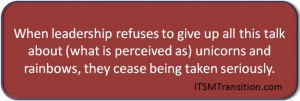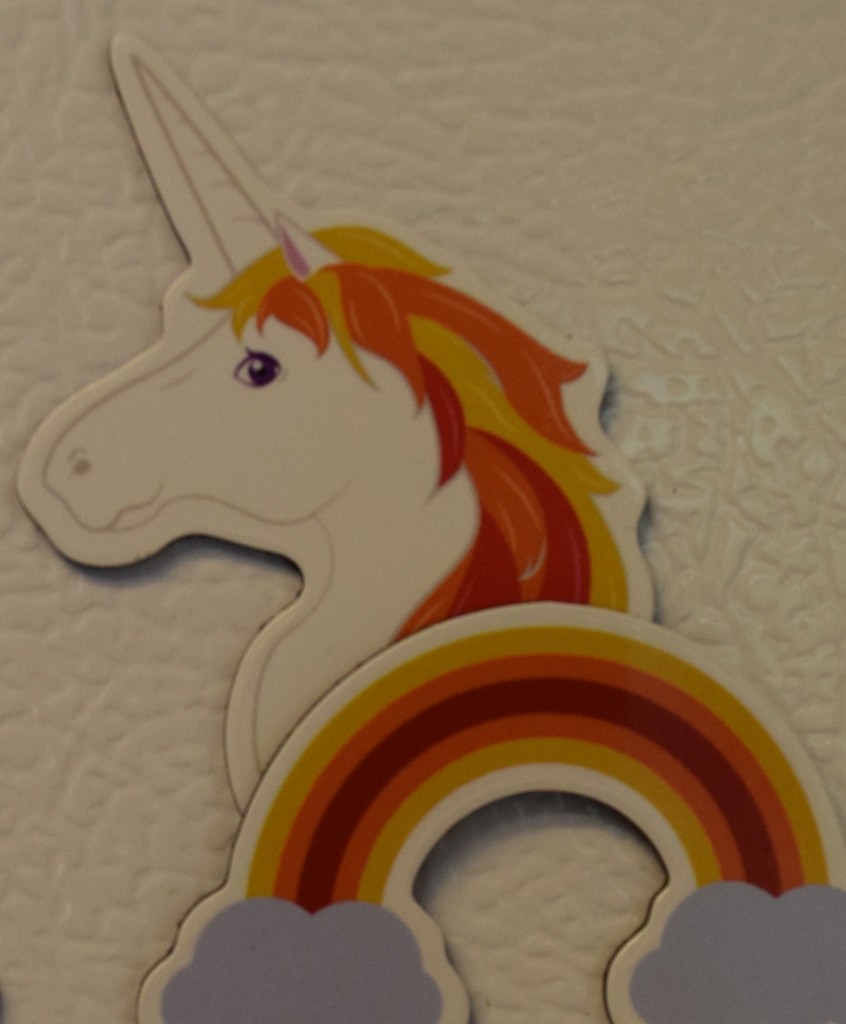What do unicorns and rainbows have to do with IT Strategic Vision and Service Management? It’s an interesting tale, and if you read on, I’ll make it worth your while. Trust me.
Here in Reality
Every IT Service Management program needs, well, any program really, is a compelling strategic vision. A future-state that motivates and inspires. That’s basic Management of Change.
It’s also how you get people on board. It answers ‘what’s in it for me?’ and a host of other transformational needs.
But here’s the problem.
People live in the here-and-now. IT professionals are very busy, and when they’re not; they’re busy doing the stuff they were too busy to get done. There’s never a time when you get caught up. That’s reality
While many may agree on the need for change, they just don’t believe it will happen.
Here…anytime soon.
William Bridges nailed it when he talked about Why Change Fails:
They don’t understand that “explaining the change” and “justifying it” do very, very little to encourage people to let go of the assumptions they’ve always had, the relationships they’ve always depended on, or the behaviors they’ve always used to get results.
These executives’ detachment from the everyday work-work, which is so often defended as necessary to be “strategic,” keeps these people from understanding what has to happen for changes to work as planned.
The problem of leadership
The first order of business in managing a transition is to cast a strategic vision of where we’re going. People need to know what’s changing (and what’s not changing). They need a vision of what will be. They need the opportunity to see themselves being successful in that future state.
All good, right?
Yep.
But there’s a catch. All this talk about what seems like a far away and very different future is just that: far away. At least to those who have been living this reality for a long time, and doing quite well – thank you very much.
The more people don’t ‘get it’, the harder leadership tries to explain it in a misguided effort to get them to see it.
It’s a catch 22 that has a dangerous downside. Irrelevance.
Everybody loves unicorns. (If not, work with me here, will ya?) Great stories have unicorns and rainbows. In some far away dream land that’s all fluffy and happy.
Most rational adults have stopped hoping for them. They don’t exist. Not outside dreams and fairy tales, anyway.
See where I’m going here? When leadership refuses to give up all this talk about (what is perceived as) unicorns and rainbows, they cease being taken seriously.
here? When leadership refuses to give up all this talk about (what is perceived as) unicorns and rainbows, they cease being taken seriously.
When that happens, you’ve lost your ability to lead any change, large or small.
So, what do we do?
Start with the end in mind
Casting a vision is important. People need to know where you’re going and why. But what they need most of all is to see change happening.
Start with a clear and relevant strategic vision, but then move on to meaningful incremental steps toward the vision. Action speaks louder than words. Show them the vision by showing them forward progress.
Avoid large steps that could, in fact, fail. Better small steps that send a clear message: “things are changing”. You can talk until you’re blue in the face (which, as a side note, is a rare condition that I’m starting to doubt has ever actually happened), but until something tangible changes, it’s just talk.
It comes down to this:
- Start with the end in mind. (Know where you want to be.)
- Determine where you are now.
- Understand the organization’s capacity for change.
- Make realistic incremental improvements
- Make course corrections as needed
- Keep moving forward
Frequently the biggest challenge is inertia, not open resistance. People will “get it” when they start ‘seeing it’. Each step engineered to guarantee forward progress.
Don’t believe in unicorns and rainbows? I do. I’ve seen them. Out there surrounded by wildly fantastic strategic visions with no realistic plans to achieve.
Don’t let a good strategic vision go the way of the unicorn.
Bring it to life by breaking it into small, achievable steps. Focus your energy on forward progress, no matter how small.



3 comments on „IT Strategic Vision: The Land of Unicorns and Rainbows”